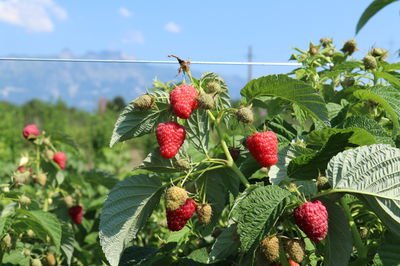 In the mid-1980s, when the raspberry variety 'Autumn Bliss' was introduced to the market, the triumphant advance of autumn raspberries began and continues to this day. Although the variety was never an aromatic miracle, it was the first variety with good, acceptable fruit on one-year-old canes. This property of growing, flowering and bearing fruit in the same year and also the associated easy maintenance of the plants, especially in the home garden, has now made the autumn raspberries more important than the summer raspberries. This is despite the fact that even the latest autumn-bearing varieties still do not quite come near the taste of a summer-bearing variety. However, in terms of taste compared to 'Autumn Bliss', there have been more than significant improvements. Also, one can hardly speak of autumn raspberries with the current varieties, as they start to mature from early to mid-July...
In the mid-1980s, when the raspberry variety 'Autumn Bliss' was introduced to the market, the triumphant advance of autumn raspberries began and continues to this day. Although the variety was never an aromatic miracle, it was the first variety with good, acceptable fruit on one-year-old canes. This property of growing, flowering and bearing fruit in the same year and also the associated easy maintenance of the plants, especially in the home garden, has now made the autumn raspberries more important than the summer raspberries. This is despite the fact that even the latest autumn-bearing varieties still do not quite come near the taste of a summer-bearing variety. However, in terms of taste compared to 'Autumn Bliss', there have been more than significant improvements. Also, one can hardly speak of autumn raspberries with the current varieties, as they start to mature from early to mid-July...
But the diversity of the autumn raspberries has also grown. There is now a wide variety of different growth forms, ripening times and fruit colours.
The classic autumn raspberries
The classic autumn raspberries are characterised by their vigorous growth, which is at least as large as a human being, in many cases even taller. In addition, these varieties are usually spined but they also have quite large fruits. Although these varieties do not need a lavish support for growing them in the home garden, there is usually no way to avoid not having something to tie up the canes. This group includes varieties such as the following:
- Autumn Bliss: this is still a well-known variety with medium-sized, sweet/sour fruits, but there are now significant improvements; the robustness of this variety is and was appreciated
- HimboTop®: an offspring of ‘Autumn Bliss’ that originated from commercial cultivation; the variety develops its full potential only in good locations with large, very uniform fruits and a fresh raspberry flavour
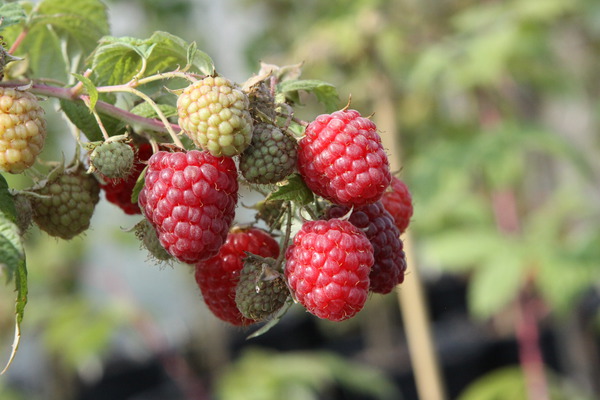
Picture: primocane raspberry 'Himbo Top'®
- Boheme: a robust Scandinavian variety with medium-sized, rounded fruits that have a slight sheen
- Aroma Queen®: also an offspring of ‘Autumn Bliss’ with a subtle aroma that is reminiscent of a wild raspberry; this variety has large fruits and the same robustness like ‘Autumn Bliss’
- Bella Aromatica®: a rich-bearing sister variety to ‘Aroma Queen®’ and thus also an offspring of ‘Autumn Bliss’; this variety is medium late and has large, bright red fruits

Picture: primocane raspberry 'Bella Aromatica'®
- Primeberry® Autumn First®: this variety comes from the Lubera® breeding programme; it has large fruits with an excellent flavour, it is early ripening and robust and thus a significant improvement to ‘Autumn Bliss’
- Primeberry® Malling Happy®: the newest upstart from the Lubera® breeding programme in East Malling, England; this variety is very rich-bearing with huge but very tasty fruits
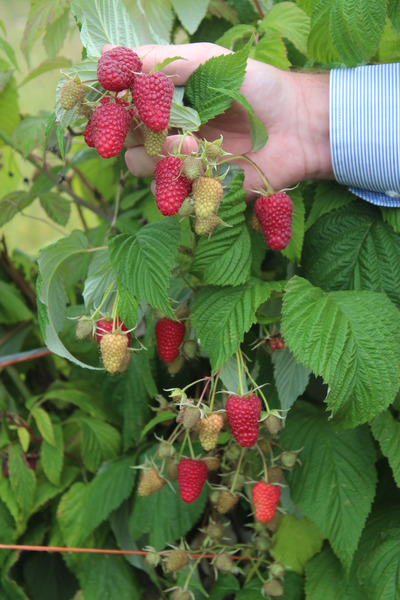
Picture: Primeberry® Malling Happy®
The compact Lowberries® - autumn raspberries for balconies and terraces
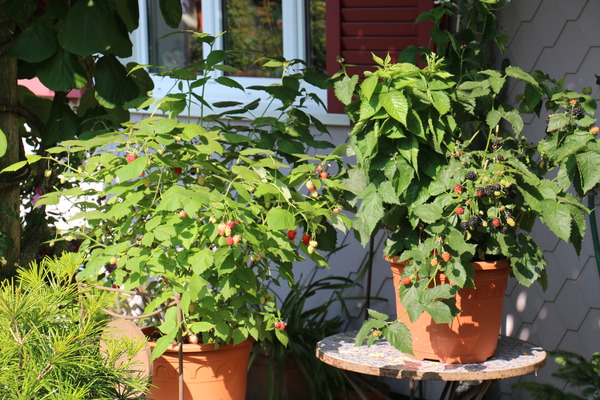
Picture: Lowberries® in deco-containers placed on patio
Lowberries® are a new generation of berry fruits, which due to their compact habit are ideal for growing in pots on balconies and terraces as well as in small gardens. These varieties mature in autumn, meaning that they bear fruit on this year’s canes. They usually grow no higher than 60 - 100 cm.
However, the Lowberries® cannot replace the classic garden varieties because they are also significantly more fertile due to their stronger growth and they usually have the larger fruits. The Lowberry® varieties are more likely to be eaten as a snack rather than using the fruit for processing.
However, even with the Lowberry® varieties, two harvests can be achieved by not cutting part of the canes completely back in autumn but by keeping them at a height of 5 - 10 cm. When they then sprout again, the flowers are formed very early in the year. The second crop comes from the one-year-old canes, which continue to grow and flower in the same year and produce fruit.
Lowberry® Little Sweet Sister® is a compact growing variety (only about 80 cm high) with very early ripening. From the middle of July, the first fruits can be harvested. The fruits are medium-sized and have an intense dark red colour; they taste aromatic/sweet and have a fine acidity.
As the name implies, Lowberry® Goodasgold® is the yellow counterpart to Little Sweet Sister® and perfectly complements the Lowberry® range. The bright yellow fruits ripen about the same time as Little Sweet Sister®, also on the one-year-old canes. The fruits are medium-sized; they have a round shape and a pleasant, balanced flavour.
Lowberry® Baby Dwarf® is the dwarf among the raspberries. This variety is extremely unusual for a raspberry because it does not grow higher than 50 cm; this makes it an exception even in the Lowberry® group. The fruits develop at the end of the canes and also at the tips of the side shoots. Accordingly, it is considered to be an autumn raspberry. However, fruits are also produced on the overwintered canes. Depending on the plant height, the fruits are only small to medium-sized, but they have a very good flavour with an intense raspberry aroma.
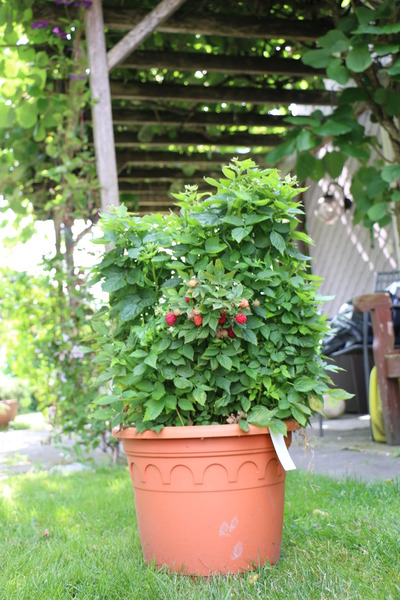
Picture: Lowberry® Baby Dwarf®
The new Schlaraffia® raspberries
The group of Schlaraffia® raspberries was first presented at the International Plant Fair (IPM) 2019 by our sister company Lubera®. These raspberry varieties are quite easy to grow and they work for the home gardener. Once planted in the garden, Schlaraffia® raspberries yield very large crops without too much horticultural input. The basic features of this group are the following:
- Medium high growth with an ideal height of 120-150 cm; all of the fruits are easy to reach
- Completely thornless
- Extremely high yielding with minimal effort
- Easy in almost every way: little susceptibility to disease, reliable, robust, high yielding
Schlaraffia® Naschmich® (Nibbleme) is a very early autumn raspberry; the main harvesting window of this variety starts already in mid-July and lasts until the beginning/middle of August. At this ripening time one can hardly speak of an 'autumn raspberry'. The very large fruits ripen at the end of the upright and stable canes. The fruit size is reduced only slightly as the harvest progresses.
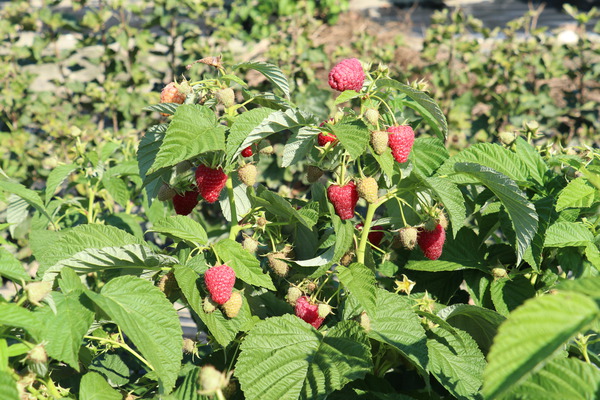
Picture: Schlaraffia® raspberry Naschmich®
Schlaraffia® Plentiful® is also a very early autumn raspberry, but a bit later than Naschmich® (Nibbleme). No other variety can match the extraordinary fertility of this variety. The main harvest window of Plentiful® is between the end of July and the beginning of August. With the onset of ripeness, the fruits are still very large, almost huge, but this changes during the harvest period. In the middle of the main crop the fruits are still medium-sized. This is simply due to the exceptional fertility, but it does not stand in the way of an excessive yield since more than enough fruit ripens. After the main harvest window, the lateral shoots begin to flower and bear fruit, allowing the harvest to last well into the autumn months.
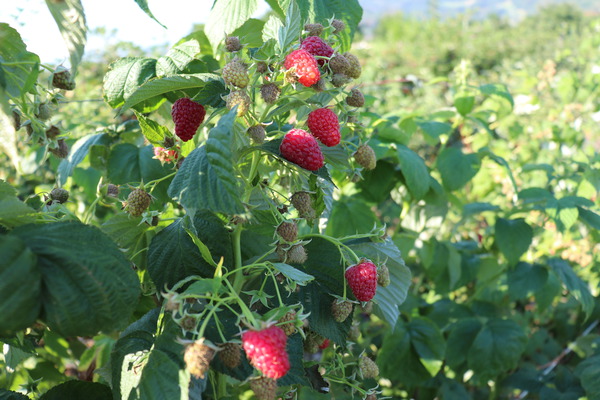
Picture: Schlaraffia® raspberry 'Plentiful'®
Autumn Bliss – a pioneer, well-tried but no longer 'up-to-date'
More than 30 years ago, the market launch of the variety 'Autumn Bliss' started a new era amongst raspberries. Although its robustness is still a strong argument for this variety, characteristics such as fruit size or flavour of newer varieties are far surpassed. In addition, there are now significantly more different heights that come into play. Specially bred varieties for the home garden that are in the 'Autumn Bliss' segment include the following:
Primeberry® Autumn First® - when it comes down to the taste
This variety comes from the Lubera® breeding programme. In addition to the large fruits, which have a bright red colour, this variety is also impressive due to its excellent flavour. 'Autumn First' is just as robust and healthy as 'Autumn Bliss' and has the same ripening time.

Picture: Primeberry® Autumn First®
Primeberry® Autumn Belle® - a visual appearance that convinces
This variety is also a Lubera® breeding that has very beautiful, long and conical fruits with a fine structure. In addition, this variety is extremely productive and is characterised by its sweet, mild flavour and fine acidity.

Picture: Primeberry® Autumn Belle®
Primeberry® Malling Happy® - the thornless variety with the gigantic fruits
'Malling Happy®' is the result of a cooperation between Lubera® and the English breeding institute East Malling. The fruit ripeness of this variety begins at the beginning/middle of August and extends until mid-October. The completely thornless shoots bear gigantic, conical fruits that have a very beautiful, consistent appearance. Despite the large fruits, this variety has a very good aroma and is also extremely robust and therefore ideal for the home garden.
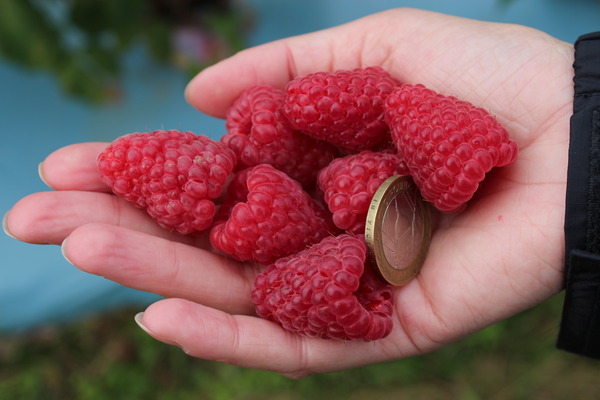
Picture: Primeberry® Malling Happy®
Aromatic autumn raspberries? - that does not necessarily have to be excluded
A stubborn prejudice against autumn raspberries, basically the same thing as with thornless blackberries, is that they are supposedly tasteless or have little or no flavour. This statement has definitely not been confirmed, but is not completely denied either. As with many false statements, there may be some truth in this.
It is true that most varieties of autumn-bearing raspberries are not at the level of the most aromatic summer raspberries. BUT, it is just as correct that some varieties of autumn raspberries taste much better than some summer raspberries.
Primeberry® Autumn Best® - probably the most aromatic autumn raspberry, but only suitable for the best locations
Primeberry® Autumn First® - as mentioned above several times, this variety has an excellent flavour
Primeberry® Autumn Amber® - an autumn variety with yellow/apricot-coloured fruits; when this variety is fully ripe it has a pink veil and a very good aroma

Picture: Primeberry® Autumn Amber®
Solu yellow(S) - this is another autumn variety with yellow-orange fruits; it reveals its true potential only when fully ripe
You have read correctly, in the list of aromatic raspberries, there are also two yellow-fruited varieties. Unlike the red raspberries, the yellow raspberries lack the red pigment in the fruits, which generally makes them taste much milder. However, the red pigment also enhances the flavour, which makes the yellow fruits less complex, but this is not so with the listed varieties.
Colour deviations from the red varieties
Raspberries are basically red, which is why you will never find special colours of raspberries at food retailers. However, special raspberry colours have been around for quite a long time, for example the variety ‘Yellow Antwerp’ was mentioned for the first time more than 200 years ago. There will always be a certain percentage of special colours in seedling stocks. However, the special colours are not limited to yellow or related colours; there are also black-fruited varieties. This fruit colour is originally from North America.
Initially, the special colours were only found in summer-bearing varieties, meanwhile, however, the breeding has progressed so far that nowadays all of the colours and colour variations can also be found in the autumn-bearing raspberries.
Primeberry® Malling Passion® - this is the first violet-coloured autumn raspberry on the market. The fruits are medium-sized to large; they have a dark purple colour and are occasionally slightly frosted. They are characterised by their exotic-spicy aroma and fresh, juicy flavour.

Picture: Primeberry® Malling Passion®
Primeberry® Autumn Amber® - this is a thornless variety with large, yellow/apricot-coloured fruits that have a pleasantly mild flavour but a good raspberry aroma.
Solu yellow(S) - this variety has yellow-orange fruits that are pleasantly sweet without much acidity but with a convincing aroma. The fruit maturity is medium early, starting in mid-August.
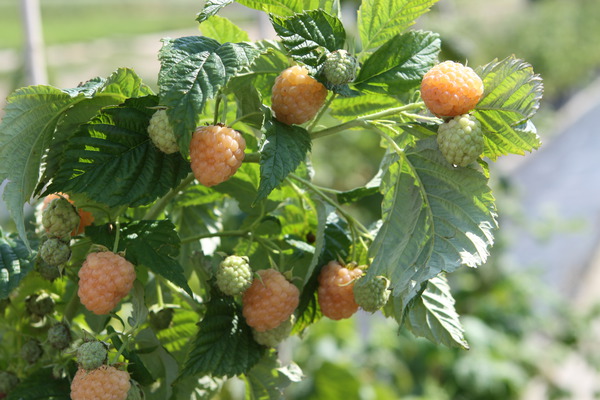
Picture: primocane raspberry 'Solu yellow'(S)
Click here for more information.
Would you like more information, an individual consultation or information about additional ranges?
Click here for the complete 2019 catalogue, which can be downloaded.
If you have specific questions, please do not hesitate to contact our customer service, where you can also spontaneously place an order.
And of course we are always there for you via telephone.
If you want to be regularly informed about news, etc., you can also subscribe to our gardener newsletter here, which we send out about once a month - it's worth it!
